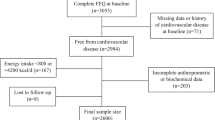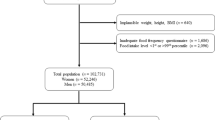Abstract
Purpose
Several mechanisms have been described through which dietary intake of choline and its derivative betaine may be associated in both directions with subclinical atherosclerosis. We assessed the association of dietary intake of choline and betaine with cardiovascular risk and markers of subclinical cardiovascular disease.
Methods
Data from 3924 Jackson Heart Study (JHS) African-American participants with complete food frequency questionnaire at baseline and follow-up measurements of heart disease measures were used. Multivariable linear regression models were employed to assess associations between choline and betaine intake with carotid intima-media thickness, coronary artery calcium, abdominal aortic calcium and left ventricular mass. Cox proportional hazards regression models were used to estimate associations with time to incident coronary heart disease (CHD), ischemic stroke and cardiovascular disease (CVD).
Results
During an average nine years of follow-up, 124 incident CHD events, 75 incident stroke events and 153 incident CVD events were documented. In women, greater choline intake was associated with lower left ventricular mass (p = 0.0006 for trend across choline quartiles) and with abdominal aortic calcium score. Among all JHS participants, there was a statistically significant inverse association between dietary choline intake and incident stroke, β = −0.33 (p = 0.04). Betaine intake was associated with greater risk of incident CHD when comparing the third quartile of intake with the lowest quartile of intake (HR 1.89, 95 % CI 1.14, 3.15).
Conclusions
Among our African-American participants, higher dietary choline intake was associated with a lower risk of incident ischemic stroke, and thus putative dietary benefits. Higher dietary betaine intake was associated with a nonlinear higher risk of incident CHD.
Similar content being viewed by others
References
Niculescu MD, Zeisel SH (2002) Diet, methyl donors and DNA methylation: interactions between dietary folate, methionine and choline. J Nutr 132(8 Suppl):2333S–2335S
Zeisel SH (2008) Is there a new component of the Mediterranean diet that reduces inflammation? Am J Clin Nutr 87(2):277–278
Dong C, Yoon W, Goldschmidt-Clermont PJ (2002) DNA methylation and atherosclerosis. J Nutr 132(8 Suppl):2406S–2409S
Zaina S, Lindholm MW, Lund G (2005) Nutrition and aberrant DNA methylation patterns in atherosclerosis: more than just hyperhomocysteinemia? J Nutr 135(1):5–8
da Costa KA, Gaffney CE, Fischer LM, Zeisel SH (2005) Choline deficiency in mice and humans is associated with increased plasma homocysteine concentration after a methionine load. Am J Clin Nutr 81(2):440–444
Homocysteine Studies C (2002) Homocysteine and risk of ischemic heart disease and stroke: a meta-analysis. JAMA. J Am Med Assoc 288(16):2015–2022
Wu LL, Wu JT (2002) Hyperhomocysteinemia is a risk factor for cancer and a new potential tumor marker. Clin Chim Acta 322(1–2):21–28
Seshadri S, Beiser A, Selhub J, Jacques PF, Rosenberg IH, D’Agostino RB, Wilson PW, Wolf PA (2002) Plasma homocysteine as a risk factor for dementia and Alzheimer’s disease. N Engl J Med 346(7):476–483
van Meurs JB, Dhonukshe-Rutten RA, Pluijm SM, van der Klift M, de Jonge R, Lindemans J, de Groot LC, Hofman A, Witteman JC, van Leeuwen JP et al (2004) Homocysteine levels and the risk of osteoporotic fracture. N Engl J Med 350(20):2033–2041
Zeisel SH (2000) Choline: an essential nutrient for humans. Nutrition 16(7–8):669–671
Shaw GM, Finnell RH, Blom HJ, Carmichael SL, Vollset SE, Yang W, Ueland PM (2009) Choline and risk of neural tube defects in a folate-fortified population. Epidemiology 20(5):714–719
Bae S, Ulrich CM, Neuhouser ML, Malysheva O, Bailey LB, Xiao L, Brown EC, Cushing-Haugen KL, Zheng Y, Cheng TY et al (2014) Plasma choline metabolites and colorectal cancer risk in the Women’s Health Initiative Observational Study. Cancer Res 74(24):7442–7452
Dalmeijer GW, Olthof MR, Verhoef P, Bots ML, van der Schouw YT (2008) Prospective study on dietary intakes of folate, betaine, and choline and cardiovascular disease risk in women. Eur J Clin Nutr 62(3):386–394
Zeisel SH (2013) Metabolic crosstalk between choline/1-carbon metabolism and energy homeostasis. Clin Chem Lab Med 51(3):467–475
Detopoulou P, Panagiotakos DB, Antonopoulou S, Pitsavos C, Stefanadis C (2008) Dietary choline and betaine intakes in relation to concentrations of inflammatory markers in healthy adults: the ATTICA study. Am J Clin Nutr 87(2):424–430
Bidulescu A, Chambless LE, Siega-Riz AM, Zeisel SH, Heiss G (2007) Usual choline and betaine dietary intake and incident coronary heart disease: the Atherosclerosis Risk in Communities (ARIC) study. BMC Cardiovasc Disord 7:20
Taylor HA Jr (2005) The Jackson Heart Study: an overview. Ethn Dis 15(4 Suppl 6):S6-1–S6-3
Taylor HA Jr, Wilson JG, Jones DW, Sarpong DF, Srinivasan A, Garrison RJ, Nelson C, Wyatt SB (2005) Toward resolution of cardiovascular health disparities in African Americans: design and methods of the Jackson Heart Study. Ethn Dis 15(4 Suppl 6):S6-4–S6-17
Carithers T, Dubbert PM, Crook E, Davy B, Wyatt SB, Bogle ML, Taylor HA Jr, Tucker KL (2005) Dietary assessment in African Americans: methods used in the Jackson Heart Study. Ethn Dis 15(4 Suppl 6):S6-49–S6-55
Zeisel SH, Mar MH, Howe JC, Holden JM (2003) Concentrations of choline-containing compounds and betaine in common foods. J Nutr 133(5):1302–1307
Newell A (2006) USDA launches searchable database of foods. AWHONN Lifelines 10(2):167–169
Miller PE, Mitchell DC, Harala PL, Pettit JM, Smiciklas-Wright H, Hartman TJ (2011) Development and evaluation of a method for calculating the Healthy Eating Index-2005 using the nutrition data system for research. Public Health Nutr 14(2):306–313
Bidulescu A, Chambless LE, Siega-Riz AM, Zeisel SH, Heiss G (2009) Repeatability and measurement error in the assessment of choline and betaine dietary intake: the Atherosclerosis Risk in Communities (ARIC) study. Nutr J 8:14
Keku E, Rosamond W, Taylor HA Jr, Garrison R, Wyatt SB, Richard M, Jenkins B, Reeves L, Sarpong D (2005) Cardiovascular disease event classification in the Jackson Heart Study: methods and procedures. Ethn Dis 15(4 Suppl 6):S6-62–S6-70
Taylor HA Jr (2003) Establishing a foundation for cardiovascular disease research in an African-American community: the Jackson Heart Study. Ethn Dis 13(4):411–413
Levey AS, Stevens LA, Schmid CH, Zhang YL, Castro AF 3rd, Feldman HI, Kusek JW, Eggers P, Van Lente F, Greene T et al (2009) A new equation to estimate glomerular filtration rate. Ann Intern Med 150(9):604–612
Foppa M, Duncan BB, Rohde LE (2005) Echocardiography-based left ventricular mass estimation: how should we define hypertrophy? Cardiovasc Ultrasound 3(1):1–13
Gatto NM, Henderson VW, St John JA, McCleary C, Detrano R, Hodis HN, Mack WJ (2009) Subclinical atherosclerosis is weakly associated with lower cognitive function in healthy hyperhomocysteinemic adults without clinical cardiovascular disease. Int J Geriatr Psychiatry 24(4):390–399
Agatston AS, Janowitz WR, Hildner FJ, Zusmer NR, Viamonte M Jr, Detrano R (1990) Quantification of coronary artery calcium using ultrafast computed tomography. J Am Coll Cardiol 15(4):827–832
Fernandez-Sola J (2015) Cardiovascular risks and benefits of moderate and heavy alcohol consumption. Nat Rev Cardiol 12(10):576–587
Marshall TA (2011) Dietary guidelines for Americans, 2010: an update. J Am Dent Assoc 142(6):654–656
Devereux RB, Alonso DR, Lutas EM, Gottlieb GJ, Campo E, Sachs I, Reichek N (1986) Echocardiographic assessment of left ventricular hypertrophy: comparison to necropsy findings. Am J Cardiol 57(6):450–458
Haring B, Wang W, Lee ET, Jhamnani S, Howard BV, Devereux RB (2015) Effect of dietary sodium and potassium intake on left ventricular diastolic function and mass in adults</=40 years (from the Strong Heart Study). Am J Cardiol 115(9):1244–1248
Institute SAS: SAS/STAT user’s guide, version 8. 1999
Institute of Medicine, Food and Nutrition Board (1998) Dietary reference intakes for thiamin, riboflavin, niacin, vitamin B6, folate, vitamin B12, pantothenic acid, biotin, and choline. The National Academies Press, Washington. doi:10.17226/6015
Craig SA (2004) Betaine in human nutrition. Am J Clin Nutr 80(3):539–549
Milani RV, Lavie CJ (2008) Homocysteine: the Rubik’s cube of cardiovascular risk factors. Mayo Clin Proc 83(11):1200–1202
Medina M, Urdiales JL, Amores-Sanchez MI (2001) Roles of homocysteine in cell metabolism: old and new functions. Eur J Biochem/FEBS 268(14):3871–3882
Finkelstein JD, Harris BJ, Kyle WE (1972) Methionine metabolism in mammals: kinetic study of betaine-homocysteine methyltransferase. Arch Biochem Biophys 153(1):320–324
Steenge GR, Verhoef P, Katan MB (2003) Betaine supplementation lowers plasma homocysteine in healthy men and women. J Nutr 133(5):1291–1295
Cho E, Zeisel SH, Jacques P, Selhub J, Dougherty L, Colditz GA, Willett WC (2006) Dietary choline and betaine assessed by food-frequency questionnaire in relation to plasma total homocysteine concentration in the Framingham Offspring Study. Am J Clin Nutr 83(4):905–911
Ide T, Shimano H, Yahagi N, Matsuzaka T, Nakakuki M, Yamamoto T, Nakagawa Y, Takahashi A, Suzuki H, Sone H et al (2004) SREBPs suppress IRS-2-mediated insulin signalling in the liver. Nat Cell Biol 6(4):351–357
Purohit V, Abdelmalek MF, Barve S, Benevenga NJ, Halsted CH, Kaplowitz N, Kharbanda KK, Liu Q-Y, Lu SC, McClain CJ et al (2007) Role of S-adenosylmethionine, folate, and betaine in the treatment of alcoholic liver disease: summary of a symposium. Am J Clin Nutr 86(1):14–24
Muraoka T, Aoki K, Iwasaki T, Shinoda K, Nakamura A, Aburatani H, Mori S, Tokuyama K, Kubota N, Kadowaki T et al (2011) Ezetimibe decreases SREBP-1c expression in liver and reverses hepatic insulin resistance in mice fed a high-fat diet. Metab, Clin Exp 60(5):617–628
Bertoia ML, Pai JK, Cooke JP, Joosten MM, Mittleman MA, Rimm EB, Mukamal KJ (2014) Plasma homocysteine, dietary B vitamins, betaine, and choline and risk of peripheral artery disease. Atherosclerosis 235(1):94–101
Cho E, Holmes MD, Hankinson SE, Willett WC (2010) Choline and betaine intake and risk of breast cancer among post-menopausal women. Br J Cancer 102(3):489–494
Cho E, Willett WC, Colditz GA, Fuchs CS, Wu K, Chan AT, Zeisel SH, Giovannucci EL (2007) Dietary choline and betaine and the risk of distal colorectal adenoma in women. J Natl Cancer Inst 99(16):1224–1231
Kotsopoulos J, Hankinson SE, Tworoger SS (2010) Dietary betaine and choline intake are not associated with risk of epithelial ovarian cancer. Eur J Clin Nutr 64(1):111–114
Lee JE, Giovannucci E, Fuchs CS, Willett WC, Zeisel SH, Cho E (2010) Choline and betaine intake and the risk of colorectal cancer in men. Cancer Epidemiol, Biomark Prev 19(3):884–887
Wang Z, Klipfell E, Bennett BJ, Koeth R, Levison BS, Dugar B, Feldstein AE, Britt EB, Fu X, Chung YM et al (2011) Gut flora metabolism of phosphatidylcholine promotes cardiovascular disease. Nature 472(7341):57–63
Acknowledgments
The JHS is supported and conducted in collaboration with Jackson State University (N01-HC-95170), University of Mississippi Medical Center (N01-HC-95171), and Tougaloo College (N01-HC-95172) NIH contracts from the National Heart, Lung, and Blood Institute (NHLBI) and the National Center on Minority Health and Health Disparities (NCMHD) with additional support from NHLBI contract HL076784 and the National Institute of Aging (AG028321). The investigators thank JHS study participants and staff for their valuable contributions and acknowledge the important contributions of Janice Maras, at Northeastern University, to the calculation of the choline and betaine variables. The results described in this article have been presented in part during the American Heart Association Scientific Sessions Conference, November 2014 in Chicago, IL, USA. AB and KLT designed research; HRM, SKM and AB conducted research; HRM, SKM, DTD and AB analyzed data; AB, DTD and KLT wrote the paper; and AB had primary responsibility for final content. All authors read and approved the final manuscript.
Author information
Authors and Affiliations
Corresponding author
Ethics declarations
Conflict of interest
None of the authors had a personal or financial conflict of interest.
Rights and permissions
About this article
Cite this article
Millard, H.R., Musani, S.K., Dibaba, D.T. et al. Dietary choline and betaine; associations with subclinical markers of cardiovascular disease risk and incidence of CVD, coronary heart disease and stroke: the Jackson Heart Study. Eur J Nutr 57, 51–60 (2018). https://doi.org/10.1007/s00394-016-1296-8
Received:
Accepted:
Published:
Issue Date:
DOI: https://doi.org/10.1007/s00394-016-1296-8




